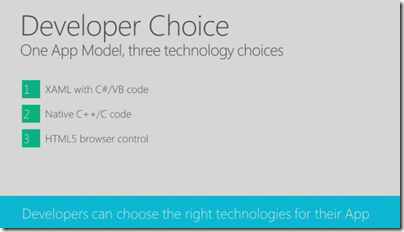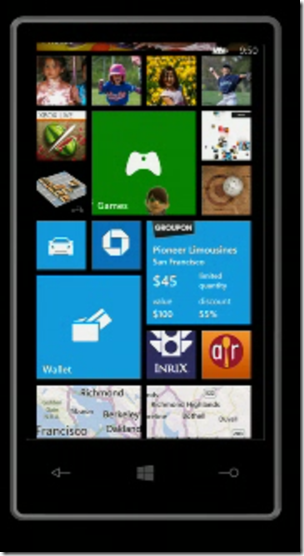Microsoft has shared details of the forthcoming Windows Phone 8 operating system, which is set to be available on devices before the end of 2012.
The improvements are fundamental, and it seems that Microsoft has finally created a mobile platform that has what it takes, technically, to compete in the modern smartphone market. Winning share from competitors is another thing of course; Nokia’s hoped-for third ecosystem is still tiny relative to Apple iOS or Google Android.
It starts with a change in the core operating system, from Windows CE to Windows 8. The two now share the same kernel, and APIs including Graphics, Audio, Media, File System, Networking, Input, Commerce, Base Types and Sensors. The .NET Framework is also the same. The browser will be Internet Explorer 10.
Silverlight was not mentioned, nor was XNA, though we were told that Windows Phone 7.x apps will run on Windows Phone 8.
The change does enable multi-core support at last. Screen resolution can now go up to 1280 x 768, ready for high-definition displays. There is also support for MicroSD storage, a feature which should have been in the first release.
What about Windows RT, the runtime for Metro-style apps in Windows 8? Here is the significant slide from yesterday’s presentation:
This looks similar to Windows RT, which also supports three development models: XAML and .NET, native C/C++ code, and HTML5. It is not quite the same though. One thing I did not hear mentioned was contracts, the communication and file sharing system built into Windows 8, though we were promised “sharing under user control”. Nor did we hear about language “projections”, the layer that lets different languages in Windows 8 call the same Windows Runtime APIs. My guess at the moment is that Windows Phone 8 does not include the Windows Runtime, though it does have much in common with it. The further guess is that the full Windows Runtime will come in Windows Phone 9.
In other words, it seems that Windows Phone 8 will not run apps coded for Windows 8, though we were told that if you code to the XAML and .NET model for apps, and the native code model for games, few changes will be needed. XNA developers should consider a change of direction.
Support for C/C++ is a key feature and one that in my view should have been in the first Windows Phone release. One of the things it enables is official support for SQLite, the cross-platform database engine also found in Mac OS X and numerous other platforms. A good day for SQLite, which pleases me as I am a fan.
There will also be C/C++ gaming libraries coming to Windows Phone 8, including Havoc:
What else is new? Users will like the new Start screen, which unlike the whole of Windows Phone 8 is also coming to existing devices, which will get a half-way upgrade called Windows Phone 7.8 (7 and 8, geddit?). The innovation in the new Start screen is that any tile can be sized by the user to any of the supported sizes. The smallest size allows four tiles across, so you can make your Windows Phone look more like Android or iOS if you so choose.
What else? Microsoft is not announcing “end-user features” yet, but did promise Nokia offline maps plus turn by turn directions; digital wallet which can be paired with a secure SIM for NFC (near field communications) payment, and deep support for Skype and VOIP so they “feel like any other call”. Apparently operators will love the way the wallet is implemented, because unlike Android it is hooked to the SIM, but I doubt they will be so keen on Skype.
There is an improved speech engine which duly failed to recognise speech input correctly in the first demo, though it worked after that.
Finally, Microsoft is now talking Enterprise for Windows Phone. There will be bitlocker encryption and enterprise app deployment without Windows store, as well as device management. Think full System Center 2012 integration.
Conclusion? There is disappointment that existing Windows Phone 7 devices are not fully upgradeable, but this is hardly surprising given the changed core. As a platform it is greatly improved, though I would like to see full WinRT included. Despite its poor start, you cannot dismiss this mobile OS as Microsoft continues to use its financial muscle to try and try again.
If it succeeds, will it be too late for Nokia? Maybe, though my hunch is that Microsoft will do what it takes to keep its key mobile partner alive.




The .NET Compact Framework had a *terrible* garbage collector. So the move to desktop .NET is an enormous improvement. And since .NET now has multithreaded background garbage collection, the dual-core support is coming just in time.
They must have projections, since that’s needed to avoid blitting/boxing when calling into the runtime. I suspect the fundamentals of WinRT have largely been kept intact — but a bunch of API calls may be missing.
Microsoft has to keep Nokia alive. If they don’t, they might as well give up on mobile and add the $1 billion a year to the dividend. There are fewer launch partners on Windows Phone 8 than Windows Phone 7.
I WANT SQLITE DATABASE FOR WINDOWS PHONE 7 USING JAVASCRIPT,HTML5………………
Its all about time and timing. Windows phone 8 and windows 8 should have been under the same platform even from the first release. Even with HTML 5 app development still needs different branches and configuration management to address these two so common yet different platforms.
So the question is: can Microsoft and Nokia wait for these platforms not just to converge but be the sane? The most evident answer is no, and this is justified by the rush for WP7, WP 7.8 and WP 8, let aside Windows 8.
In any case, Microsoft is still trying to catch up with the mobile industry (phone and tablet) rather than innovating and leading the way. In contrast to the desktop OS, consumers are nowadays more educated, more demanding and more free to move from one platform to another.
@Stavros “Its all about time and timing”
But how much time does MS have? A look at the raw numbers is not encouraging:
http://www.asymco.com/wp-content/uploads/2012/06/Screen-Shot-2012-06-15-at-6-15-1.30.21-PM.png
Squint to see Windows Phone in the lower-left. Now assume a wildly optimistic scenario in which WP8 takes off like iOS and Android did. In other words, in about 2 years from now, WP8 would be at about 10% of today’s combined iOS+Android base. However, 100s of millions of additional iOS and Android devices will be shipped in those 2 years as well, meaning the % will be less than 10%. Will a single-digit base be enough 2 years from now?
Another obstacle is this very convergence. I doubt if that means much to most users. Does it even mean much to mobile developers? Take a look at the just-released “Developer Economics 2012: The new mobile app economy” report (http://www.visionmobile.com/product/developer-economics-2012/) and cogitate on this surprising conclusion:
“To attract more developers into Windows Phone, Microsoft also needs to rethink its tool strategy. At present, developing on Windows Phone 7 requires a Windows PC, which presents a barrier to entry for iOS developers and the many web developers who are using a Mac. Support of WP7 development on a Mac is therefore crucial for reducing the onboarding friction for iOS and web developers.”
All I can think of is that many of the developers in their survey must use only Macs and perhaps are indifferent to Windows altogether. If true and assuming these are the very devs that MS hopes to attract to Win8, then that represents a new and very strange state of affairs for MS.
Thanks.
-Phil